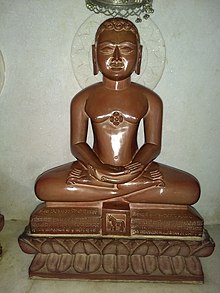Sambhavanatha
| Sambhavanatha | |
|---|---|
3rd Jain Tirthankara | |
 Sambhavanatha statue at Sudarshanoday Teerth Kshetra, Anwa | |
| Venerated in | Jainism |
| Predecessor | Ajitanatha |
| Successor | Abhinandananatha |
| Symbol | Horse |
| Height | 400 dhanusa (1,200 meters) |
| Age | 6,000,000 purva (423.360 Quintillion Years Old) |
| Color | Golden |
| Genealogy | |
| Born | |
| Died | |
| Parents |
|
| Part of a series on |
| Jainism |
|---|
 |
Sambhavanatha was the third Jain tirthankara (omniscient teaching god) of the present age (Avasarpini). Sambhavanatha was born to King Jitārī and Queen Susena at Sravasti. His birth date was the fourteenth day of the Margshrsha shukla month of the Indian calendar. Like all arihant (omniscient beings), Sambhavanatha at the end of his life destroyed all associated karmas and attained moksha (liberation).
Life
Sambhavanatha was the third tirthankara (omniscient Jain teacher) of the present age (Avasarpini).[1] He was born to King Jitārī and Queen Susena at Sravasti.[2][3] in the Ikshvaku dynasty.[1] His height was 400 dhanusa (1,200 meters).[2] Sambavanatha is associated with Horse emblem, Sala tree,[4] Trimukha (three-faced) Yaksha and Prajnapthi & Duritari Yakshi.[5]
According to Jain text Uttarapurāṇa, Sambhavanatha possessed three types of knowledge from birth.[6]
Prayer
Svayambhustotra by Acarya Samantabhadra is the adoration of twenty-four tirthankaras. Its five slokas (aphorisms) adore the qualities of Sambhavanātha.[7]
O Lord Sambhavanātha! The worldly life appears to be transient, without a protector, sullied with the blemishes of pride and delusion, and tormented by birth, old-age and death. You had helped worldly souls attain ambrosial happiness by ridding these of the karmic dirt.
— Svayambhustotra (3-2-12)[8]
Main Temples
-
Image of Tirthankara Sambhavnatha at Gwalior Fort museum
-
Lord Sumatinatha and Lord Sambhavnatha at Ranthambore Fort
-
Sambhabnath Temple, Madhuban
-
Ruins Shobhnath temple, Shravasti, believed to be birthplace of Sambhavanath
See also
Notes
- ^ a b Tukol 1980, p. 31.
- ^ a b Vijay K. Jain 2015, p. 183.
- ^ "Sravasti", asiexbrpatna.bih.nic.in
- ^ Krishna & Amirthalingam 2014, p. 46.
- ^ Tandon 2002, p. 44.
- ^ Jain 2015, p. 15.
- ^ Vijay K. Jain 2015, p. 16-19.
- ^ Vijay K. Jain 2015, p. 17.
References
- Johnson, Helen M. (1931), Sambhavajinacaritra (Book 3.1 of the Trishashti Shalaka Purusha Caritra), Baroda Oriental Institute
- Jain, Dr. Pannalal (2015), Uttarapurāṇa of Āchārya Guṇabhadra, Bhartiya Jnanpith, ISBN 978-81-263-1738-7
- Jain, Vijay K. (2015), Acarya Samantabhadra's Svayambhustotra: Adoration of The Twenty-four Tirthankara, Vikalp Printers, ISBN 978-81-903639-7-6, archived from the original on 16 September 2015,
 This article incorporates text from this source, which is in the public domain.
This article incorporates text from this source, which is in the public domain.{{citation}}: Unknown parameter|deadurl=ignored (|url-status=suggested) (help) - Krishna, Nanditha; Amirthalingam, M. (2014) [2013], Sacred Plants of India, Penguin Books, ISBN 978-9-351-18691-5
- Tandon, Om Prakash (2002) [1968], Jaina Shrines in India (1 ed.), New Delhi: Publications Division, Ministry of Information and Broadcasting, Government of India, ISBN 81-230-1013-3
- Tukol, T. K. (1980), Compendium of Jainism, Dharwad: University of Karnataka



